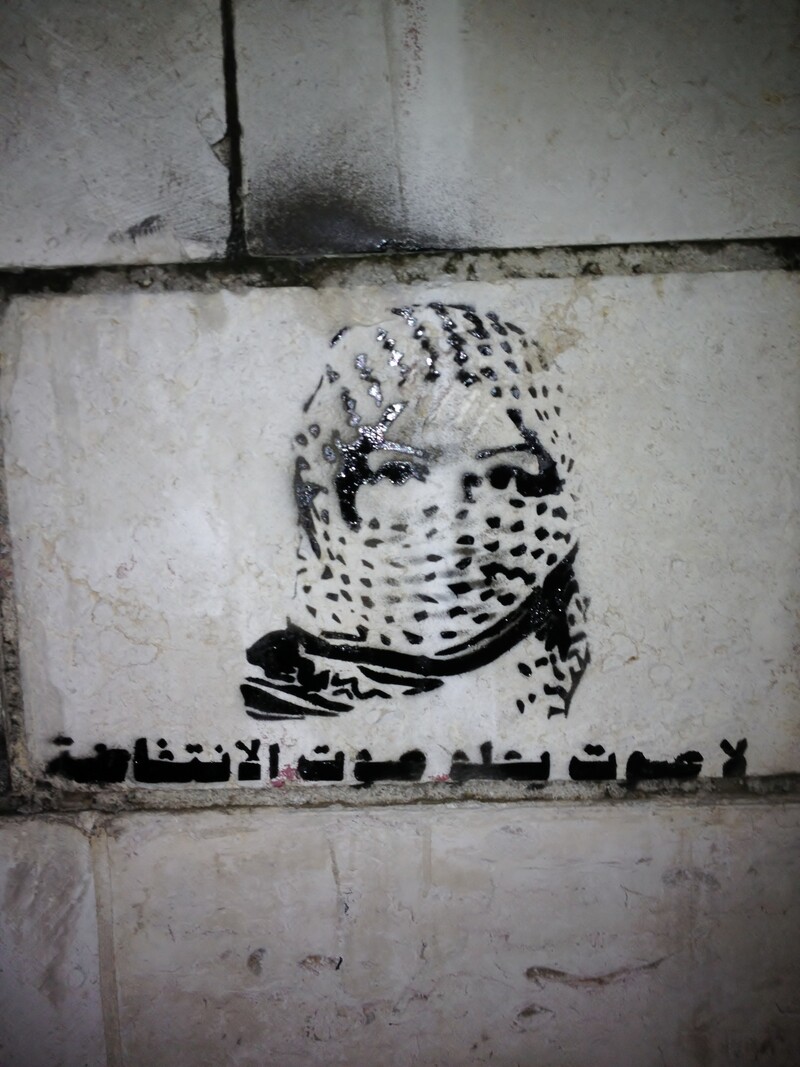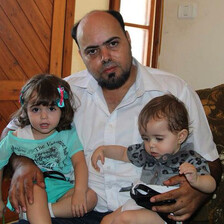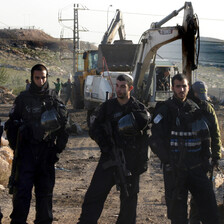The Electronic Intifada Jerusalem 29 August 2012

“There’s no voice greater than the voice of the intifada” (Image courtesy of the artist)
Graffiti has been a tool of the Palestinian liberation struggle for decades; during the first intifada in the late 1980s and early ’90s, Palestinians painted graffiti on all the walls as a means of protesting the occupation. Graffiti artists were met with brutal suppression if caught.
Young Palestinians are carrying on the legacy of art as a form of resistance today. On 12 January, an unknown group penetrated the heavily-fortified heart of West Jerusalem overnight and painted graffiti bearing political messages on walls, doors, construction sites and other surfaces. Most of the paintings pictured a woman’s face masked with a kuffiyeh, the traditional Palestinian checkered scarf. Below some of the images was the word “revolt” in Arabic.
The group hit the walls of Jerusalem again five days later, and issued an anonymous statement vowing to carry on their action to send messages to the Israeli and Palestinian communities.
In the following weeks, other groups took up the spray can torch in various cities including Haifa and Jaffa.
And in June, the Jerusalem activists took a daring step by painting graffiti on the doors and walls of governmental buildings as well as the doorways of Israeli houses in Jerusalem and Palestinian houses occupied since the ethnic cleansing of 1948. They sent the same messages calling upon Palestinians in general, and Palestinian women in particular, to revolt. They also painted “Remember Gaza” across the wall of one of the buildings in big letters.
Underground graffiti artist speaks out
A member of the group, a confident young Palestinian feminist activist who operates under the pseudonym “Laila,” spoke to The Electronic Intifada on condition of anonymity. Laila has been active in street art in Palestine before the creation of the anonymous Jerusalem group, focusing on painting both the walls of West and East Jerusalem.
“Some of the street art I have done was in what has now become West Jerusalem in Jewish-dominated areas,” said Laila. “Some other stuff I have done is in East Jerusalem where messages have been more about feminist messages to [Palestinian] women, mostly to wake up and not be drowned out by the patriarchal nature of our society.”
The Jerusalem graffiti group started operating since the beginning of this year.
“We are a group of Palestinian youth, both men and women, active on the ground in the popular resistance movement,” explained Laila, adding that there is a mix of backgrounds and perspectives within the group. “We cannot be categorized into one unique box; we are quite diverse,” she said. “What bring us together is our activism and our deep desire to continue the resistance movement and to be active as much as possible.”
The members of the group met during demonstrations taking place in Palestine. In the past year, they have been actively participating in the popular resistance in the West Bank and prisoners’ hunger strike solidarity actions. Although they have not known each other for very long, they managed to build a level of trust amongst each other. “I think each one of us realizes there is a lot of trust within the other person,” said Laila.
For the time being, the group has no plans to expand. “First we have to work small and focused until we are able to mobilize more people,” said Laila.
“This is Palestine and we’re still here”
According to Laila, the group’s street art activism in West Jerusalem aims to mark the streets with the existence of the Palestinian people and make Israelis feel uncomfortable.
“We want to remind them these were Palestinian neighborhoods, this is Palestine and we are still here,” said Laila. “It is kind of taking back our streets and not allowing the status quo to continue.
“I am not under the illusion that our street art or the unarmed demonstrations are going to end the occupation tomorrow morning. None of these things isolated from the rest of it is going to end the occupation. But they build a system of resistance. They are all part of a larger web of popular resistance.”
The Jerusalem group has so far undertaken three actions this year, all carrying similar messages. Laila said, “The three actions were in different parts of the city [Jerusalem]. We wanted to take the same message and spread it around the city. Some of the paintings were painted over within 48 hours. We wanted to make it a point: by repainting them … even if you do, the problem will not go away and we are still here.”
It is still too early to know if the work of this group will expand into different areas or using different tools. “We are planning. There will be something new in the coming weeks, so stay tuned,” Laila said.
Laila does not think of her activism as just a means to end occupation; she hopes that her work could encourage change within Palestinian society.
“The end goal is also to create a different society and a different way in which we function in it,” said Laila. “For example, when I think about the role of women within the popular resistance movement, I think about the fact that it is important that women also have an equal role within creating a new Palestinian society. Will they be part of the leadership? Will they be part of the action? Will they be part of building the structures and institutions of the society?”
Support of unarmed resistance
The unarmed popular resistance that has mushroomed in recent years in opposition to Israel’s wall and settlement colonies in the occupied West Bank has been hit with the arrows of criticism, accused as inefficient and helping to sustain the status quo. The Popular Struggle Coordination Committee organizes weekly demonstrations against the occupation in several West Bank villages. These demonstrations have not yet produced tangible changes on ground, critics say.
“Since the 1930s, the Palestinians have used multiple strategies and tactics that are all categorized as nonviolent resistance such as strikes, hunger strikes and marches,” said Laila. “For instance, the nonviolent tactics of the first intifada succeeded in mobilizing thousands of people out in the streets.
“The [nonviolent] tactic itself can bring a lot more people together. It allows higher levels of participation in oppose to the armed resistance.”
Laila believes that the unarmed resistance is the way to end the occupation. “I do not want to speak for anybody else in the group because we might not agree on this point,” said Laila. “But I think that unarmed resistance is going to be a lot more strategic and influential.”
And yet even unarmed protest, during which youths sometimes throw rocks at the army, is construed in the international media as violent. Laila believes that this characterization is unfair because the young Palestinians throwing stones at the fourth strongest army in the world are met with live ammunition or rubber-coated steel bullets.
Laila finds a double standard in the Western media. “I think the Egyptian revolution is a great example,” she said. “We saw protesters throwing stones at the army and the police, and yet the media painted it as a nonviolent revolution.”
Some have also criticized the participation of Israeli activists in the Palestinian popular resistance.
“It is important that the strategies and tactics are directed by the Palestinians,” said Laila. “But we are also talking about many Israeli activists who are anti-government and who come in full solidarity. They support the full rights of the Palestinians and justice.”
Future of Palestine
As for the future of Palestine, Laila believes that a two-state solution is impossible. According to her, the idea of a Jewish state has damaged the morality of Jewish Israeli society.
“I want to destroy the current structure and oppression inflicted by the state, not the people,” said Laila.
“There are so many Jews who want to go back to Syria because that is their homeland,” she added. “They want to go back to Tunisia or Morocco because that is where they are originally from. I know Israeli Jews who cried when they saw the bombing of Baghdad in 2003 because that is their home city.”
The graffiti activist believes that all Palestinians in exile have the right to choose whether they want to return to their homeland or be compensated. She believes that the right of return might not be easy but it is not impractical as many Zionists claim. It is a right, she says.
“I do not think anyone will be left homeless; there are a lot of structures,” said Laila. “Instead of thinking about destroying the settlements the day the occupation ends, we should think about how we can use these structures. There are also Palestinian Nakba houses [property depopulated in the 1948 ethnic cleansing] that are standing completely empty and nobody uses them. Why should their owners not have the right to come back?”
Laila is not interested in sending messages of co-existence through her graffiti art. “This is the only place in the world that I know of where reconciliation and dialogue programs and messages of co-existence have existed before actual oppression has ended,” she said. “It is impossible to tell somebody [to] learn to co-exist before their sense of oppression has ended.”
It is Israeli society which needs to reconcile with history, according to Laila. “The Israeli society will suffer an identity crisis before they start realizing what the occupation meant here for all of those years,” she said.
“I do not talk just about the occupation in 1967,” she added. “My village was not impacted in 1967; it was impacted in 1948. My village was occupied in 1948.”
As for the Palestinians, following the so-called Arab Spring, many Palestinian youth groups emerged. Nonetheless, mobilization seems to be slow. Many analysts ask the same question: “When is the Palestinian spring?”
Laila believes that Palestinian society needs more time to prepare for the next phase of their liberation movement. “If it [the revolution] happened tomorrow morning, it would be a disaster,” Laila said. “What we are doing today is preparing. It is utterly important to be ready for the day when it comes.”
Maath Musleh is a Palestinian journalist and blogger based in Jerusalem currently seeking a master’s degree in political journalism from City University in London.





